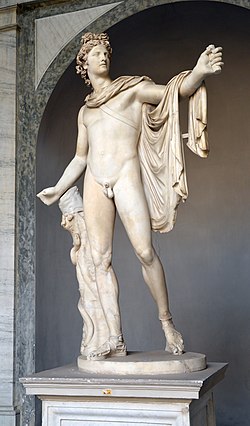Apollo Belvedere
 |
|
| Artist | after Leochares |
|---|---|
| Year | Circa 120–140; copy of bronze original of ca. 350–325 BC. |
| Type | White marble |
| Dimensions | 224 cm (88 in) |
| Location | Vatican Museums, Vatican City |
The Apollo Belvedere or Apollo of the Belvedere—also called the Pythian Apollo—is a celebrated marble sculpture from Classical Antiquity. It was rediscovered in central Italy in the late 15th century, during the Renaissance. From the mid-18th century it was considered the greatest ancient sculpture by ardent neoclassicists, and for centuries epitomized ideals of aesthetic perfection for Europeans and westernized parts of the world. It is now found in the Gabinetto delle Maschere of the Pio-Clementine Museum of the Vatican Museums complex.
The Greek god Apollo is depicted as a standing archer having just shot an arrow. Although there is no agreement as to the precise narrative detail being depicted, the conventional view has been that he has just slain the serpent Python, the chthonic serpent guarding Delphi—making the sculpture a Pythian Apollo. Alternatively, it may be the slaying of the giant Tityos, who threatened his mother Leto, or the episode of the Niobids.
The large white marble sculpture is 2.24 m (7.3 feet) high. Its complex contrapposto has been much admired, appearing to position the figure both frontally and in profile. The arrow has just left Apollo's bow and the effort impressed on his musculature still lingers. His hair, lightly curled, flows in ringlets down his neck and rises gracefully to the summit of his head, which is encircled with the strophium, a band symbolic of gods and kings. His quiver is suspended across his left shoulder. He is entirely nude except for his sandals and a robe (chlamys) clasped at his right shoulder, turned up on his left arm, and thrown back.
...
Wikipedia
